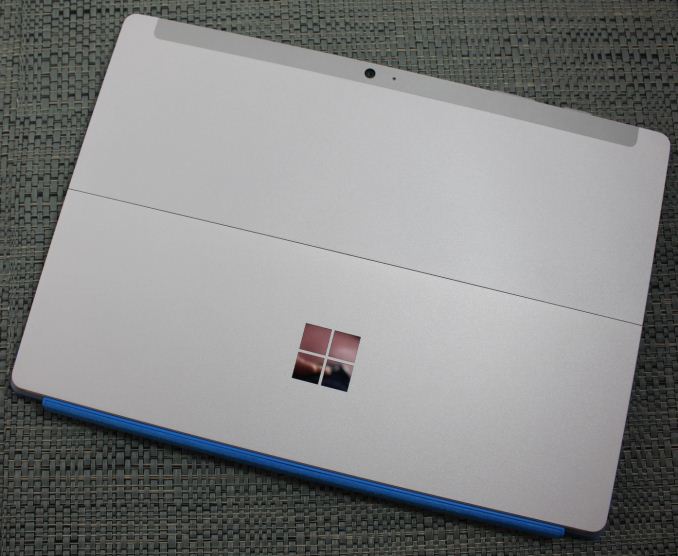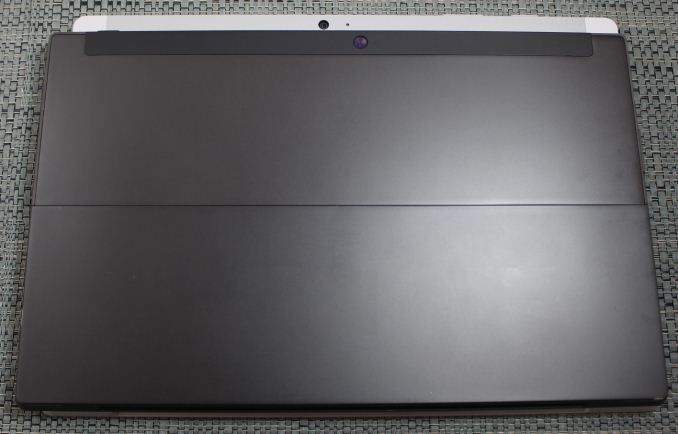The Surface 3 Review
by Brett Howse on May 4, 2015 9:00 AM EST
The Surface lineup for Microsoft has been extremely interesting to watch. What first launched in October 2012 as the Surface RT has been constantly iterated upon, and of course the Surface Pro line has evolved even faster. Surface Pro 3 has finally provided Microsoft with something that critics and consumers alike seem to have bought in to, and sales have been very strong since the Pro 3 was launched on May 20th 2014. However there has always been questions about the “consumer” version of Surface. Surface RT was, frankly, a sales disaster. The much improved Surface 2 fixed many of its shortcomings, but certainly did not set the world on fire. So now we have the third generation Surface, aptly named the Surface 3. There are a pile of changes that Microsoft has made to this generation of device, and obviously their hopes are that Surface 3 will be as popular as the Surface Pro 3 has been, but extending the device back down to a lower price point.
That price point is important. As much as the Surface Pro 3 has gained its share of fans, it is far from cheap. The most inexpensive model starts at $799, and for that you still do not get the keyboard. Surface 3 moves that bar down significantly, and the starting price is the exact same as the original Surface RT, at $499. Microsoft had to trim down the Pro model to hit this price point, but the cuts were well placed.
 Surface RT compared to Surface 3
Surface RT compared to Surface 3
I think looking at the Surface 3 in a vacuum would be improper, since the device now is really an evolution of the previous two Surface models. From a build quality standpoint, the original Surface RT was top notch, with its VaporMg case, the revolutionary kickstand, and high attention to detail for all of the aspects from buttons to display. I think in 2015 it is pretty obvious what the shortcomings of the Surface RT were though. Performance was less than acceptable with the Tegra 3 SoC on board, and Surface RT was handicapped with the confusingly named Windows RT operating system and the lack of software compatibility that goes with using an ARM CPU instead of traditional x86. Surface 2 fixed the performance issue by moving to NVIDIA’s Tegra 4 SoC, and while not the outright fastest tablet chip, it was at least in the ballpark. However it kept the Windows RT operating system at a time when everyone else had abandoned it.
Surface 3 has fixed that final issue and at the same time made some amazing improvements to the overall design and feel. Full x86 Windows is on tap, for better or for worse, and powered by a brand new SoC. This must be a special moment in history where a Microsoft built device is the launch vehicle for a brand new product from Intel. The Surface 3 is powered by the 14nm Intel Atom x7, in this case the x7-Z8700 model which is the current top of the line Atom processor. Codenamed Cherry Trail, this is the massaged Bay Trail cores now built on Intel’s now mature 14nm FinFET process, and they include the same GPU cores as Broadwell.
| Microsoft Surface Comparison | |||
| Surface 3 (Base) | Surface 3 (High) | Surface 2 | |
| Size | 10.52 x 7.36 x 0.34 inch 267 x 187 x 8.7 mm |
10.81 x 6.79 x 0.35 inch 275 x 173 x 8.8 mm |
|
| Weight | 1.37 lbs - 622 g | 1.49 lbs - 675 g | |
| Display | 10.8-inch ClearType Full HD Plus 1920x1280 resolution, 3:2 ratio 10-point multi-touch Surface Pen Support |
10.6-inch ClearType Full HD 1920 x 1080 resolution, 16:9 ratio 5-point multi-touch |
|
| Battery | 28 Wh, 13 W AC Adapter | 31.5 Wh, 24 W AC Adapter | |
| Storage | 64GB | 128GB | 32GB or 64GB eMMC |
| RAM | 2GB | 4GB | 2GB |
| CPU | Atom x7-Z8700 Quad Core 14nm 1.6 GHz Base Frequency 2.4 GHz Burst Frequency |
NVIDIA Tegra 4 4x ARM Cortex-A15 @1.7GHz |
|
| WiFi | Marvell 802.11ac + BT 4.0 LTE Models at a later date |
802.11n + BT 4.0 | |
| Ports | USB 3.0, Mini-DisplayPort, microSD, Micro USB charging, 3.5mm Headset Jack |
USB 3.0, micro-HDMI, microSD, proprietary charging | |
| Software | Windows 8.1 Office 365 Personal with 1TB OneDrive (1-year) |
Windows RT 8.1 Office 2013 RT Home & Student Edition |
|
| Front Camera | 3.5 MP | 3.5 MP | |
| Rear Camera | 8.0 MP with Autofocus | 5.0 MP | |
| Operating System | Windows 8.1 64-bit | Windows RT 8.1 | |
| Warranty | 1-year limited | 1-year limited | |
| Price | $499 | $599 | $449 |
In addition to the new SoC, Surface 3 can be purchased with up to 128 GB of eMMC storage, and the higher storage models also come with 4 GB of RAM. This compares to the base model which is 2 GB of RAM and 64 GB of storage, which is already one of the big improvements Microsoft has made with Surface. 32 GB of storage on a Windows tablet is really the bare minimum required, and the move to 64 GB as the base is going to make this tablet far more usable. You can of course add more storage with a micro SD card, but until Windows gets the great SD card support from Windows Phone, it still means that you need to manage your storage more than you should have to.
There are so many changes with the Surface 3 that really, this is likely the Surface that most people wanted from day one, but did not know it. First up is the new (again) kickstand.










265 Comments
View All Comments
ScottSoapbox - Monday, May 4, 2015 - link
Why stop there? Microsoft should just give away the device for free. Think of the sales then!Granted Microsoft should sell the keyboard cover at $99 instead of $129, but there are actual costs involved. Forgoing margin is one thing, selling things at a loss is another. Microsoft isn't going to lose money selling something just because some people would think it nice.
BTW The 128 GB iPad is $700 and does not include a keyboard or even the option of adding a pen.
maximumGPU - Monday, May 4, 2015 - link
Yes there are costs involved, but we both know that keyboard is costing them a tiny fraction of the asking price. I personally think it's a ridiculous strategy to make up your margins with massively overpriced add-on's, doubly so when you're desperate for market share and that accessory is one of your best differentiating point.mr_tawan - Monday, May 4, 2015 - link
I actually think the same that the keyboard should come with the tablet. But then again why don't we just buy a laptop instead :-).lilmoe - Monday, May 4, 2015 - link
Because a laptop is not a tablet.I've been saying this over and over again, the Surface is a tablet first and foremost. It gives you added value in being capable of replacing your laptop if you don't lots of performance.
lilmoe - Monday, May 4, 2015 - link
edit: if don't *need* lots of performanceDrumsticks - Monday, May 4, 2015 - link
Well isn't the tablet already thinner than the pen? I'm not sure it would be worth it to increase the z height by 50% to store the pen.stburke - Monday, May 4, 2015 - link
It doesn't even include the pen, there's another $50. So $780 to really get the whole experience. This is an Apple-esque priced device.This was the Surface I had been waiting for, I'm happy with the Atom X7 performance, I like the size and the weight, but the storage performance is unacceptable. When it's upwards of $800 with lousy charging and storage performance, I'll wait to see what the Surface Pro 4 has to offer or wait another year till this thing gets refreshed.
TwiceOver - Monday, May 4, 2015 - link
Yeah, the complete package with tax for me was $824. I actually was not going to buy it and then a deal came up that made it more reasonably priced.I'm sure this thing costs quite a bit to make considering the precision and components involved. But to me, at a glance, this shouldn't be above $600 complete.
lilmoe - Monday, May 4, 2015 - link
Comparatively? This is the BEST value tablet out there as is. 64GB and 2GB of RAM are plenty for most folks buying this as a tablet first, laptop second.I'm not exactly sure what makes your computer "slow down" after a period of time except for crappy software and huge list of startup programs (ie BLOATWARE). I disable anything running in startup from the task manager. Nothing "needs" to be starting automatically when you start Windows unless you use the device solely for that app/program. I've installed Windows 7 in late 2009 and NEVER formatted or reinstalled Windows, nor had it slowing down because of software...
These eMMC drives might be comparatively "slow" but they're a heck of a lot better than any cheap consumer HDD out there in most laptops sold. Brett Howse is probably used to using SSDs exclusively, most people aren't. UFS might have been super though.
magreen - Monday, May 4, 2015 - link
"These eMMC drives might be comparatively "slow" but they're a heck of a lot better than any cheap consumer HDD out there in most laptops sold. "Not true. 33MB/s sequential write is much slower than even a cheap laptop HDD, which will be doing 80MB/s at the very slowest (and usually >100MB/s). 33MB/s is like an external hard drive over USB2.0, which can be quite laborious to use.